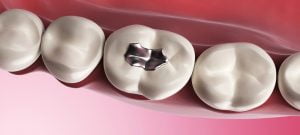The use of amalgam filling
Dentist will use a filling to restore a tooth that is damage due to decay so that it can function as normal and have its original shape back. During the process of restoring the tooth, the dentist will remove all the decayed material, clean the area, then the dentist will fill the area.
By adding a filling, the dentist can stop further decay as bacteria can’t enter the area. The filling material the dentist can use can vary from gold, porcelain, tooth coloured fillings and an amalgam filling. The amalgam filling consists of an alloy of silver, copper, tin, mercury and sometimes zinc is added. Mercury is around 50% of the mixture.
The benefits of amalgam fillings are that they are hard wearing. They lasts a long time, around 10 years but can last longer. More so, they are the least expensive. They can be completed in one dental visit. And they are less sensitive to moisture during the filling process than composite resin.
Recovery time
Your anesthesia will start to wear off in about 1 to 3 hours after the procedure. It is very important not to chew on the numb side until the anesthesia wears off. This is to prevent biting tongue, lip, etc.
Your tooth may be sensitive to hot, cold or pressure after the procedure. This is completely normal. The possible symptoms of hot, cold or pressure sensitivity will cease within a few days to a couple of weeks. In very few instances, this sensitivity could last longer than a couple of weeks. As long as your teeth or gums are continuing to feel better, everything is fine, and there is no need for concern.
Once the anesthesia has worn off, if you feel as though any of the teeth we have worked on are hitting first when you bite down, then contact your dentist. As this is an imbalance with your bite may cause further discomfort and should be adjusted.
The gum tissue could have been irritated during the procedure and may be sore for a few days. The anesthetic injection site may also feel sore or bruised.
With silver fillings, you should not chew hard foods or chew directly on the new fillings for the first 24 hours. If possible, chew only on the opposite side of your mouth.
The risks and complications
The fillings might not match your own teeth. That is since they are dark in color, therefore they are very noticeable. Where the tooth and the filling meet, there might be some discoloration as the filling corrode and tarnish. Plus, these fillings aren’t bonded to the tooth. The dentist should also create a pocket with ledges to keep the filling in place. As result the dentist has to remove some of the tooth to secure a pocket. Amalgams are able to crack the tooth.
The biggest risk is that of mercury poisoning
Although mercury for fillings are seen as safe, for adults and children ages 6 and above, by U.S. Food and Drug Administration in 2009, many other research has indicated that the use of mercury is a health concern.
The metal, mercury, occurs naturally in the environment. It exist as a liquid, but when heated it becomes a gas.
All of us are exposed to mercury through air, drinking water, soil and food such as fish from polluted waters. But low levels of mercury will not harm you. Higher levels can lead to anxiety, irritability, memory loss, headaches and fatigue. The issue with mercury over amalgam are on how much mercury fillings released and how much the body absorbs. Research in recent years has indicated that small amounts of mercury in the form of vapor can be released as the amalgam filling wears.
There is also a risk for pregnant women that mercury can cross the placenta. Thus it’s best of pregnant women to avoid any dental procedures during their pregnancy.
If you want change your amalgam filling to modern filling, then it is advisable not to replace them all at once, as it could lead to health issues. Best is to replace them as the need arises, unless you are allergic to the metals in the amalgam filling. More so removing good amalgam fillings results in unnecessary loss of healthy parts of the tooth and can release more mercury.




